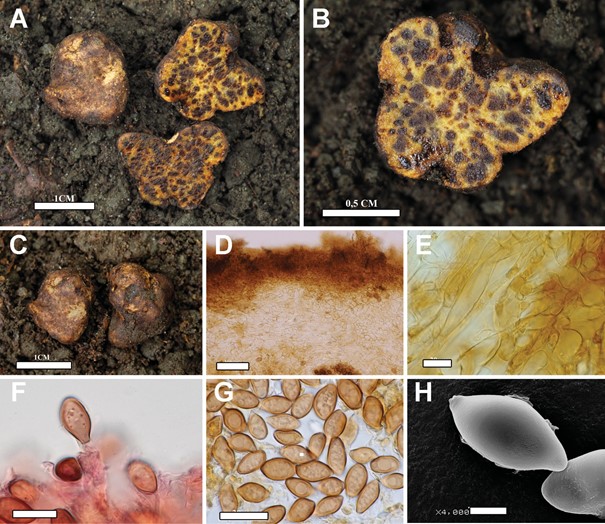Paralpova Cabero & P. Alvarado, in Alvarado, Cabero, Moreno-Mateos, Vizzini, Alonso, Lebeuf, Siquier & Vidal, Mycologia 113(4): 835 (2020)
Index Fungorum number: IF833076; Facesoffungi number: FoF12590
Diagnosis: Sequestrate hypogeous fungi with a remark- able odor, gleba with gel-filled chambers when mature, bilayered peridium (prosenchymatic peridiopellis and pseudoparenchymatic subpellis), monosporic (rarely bis- poric) basidia, ellipsoid or fusiform spores >15 µm. Associated with Fagus sylvatica.
Etymology: Paralpova, the prefix para– (Greek) mean- ing “beside” in reference to the phylogenetic placement of this genus as sister to Alpova.
Type species: Paralpova artikutzensis, sp. nov.
Notes: – Paralpova is phylogenetically distinct from Neoalpova and the core clade of Alnus-associated species of Alpova. Paralpova and Neoalpova might be inter- preted as sections of Alpova because of the pseudopar- enchymatic structure of their subpellis that is absent in Melanogaster (which has a single-layered prosenchy- matic peridium). However, Paralpova has not been reported from Alnus roots by now, has monosporic or bisporic basidia, spores >15 µm long with Qm < 2.0, and lacks clamp connections, important features different from Alpova. Therefore, a new genus is here proposed to represent these differences.

Figure 3. A–H. Paralpova artikutzensis JC180627NR (holotype). A–C. Basidiomata. D. Peridium. E. Peridium elements. F. Spores attached to basidia. G. Spores in water. H. Spore under SEM. Bars: A = 1 cm; B = 0.5 cm; C = 1 cm; D = 100 µm; E = 10 µm; F = 10 µm; G = 20 µm; H = 5 µm.
Species
